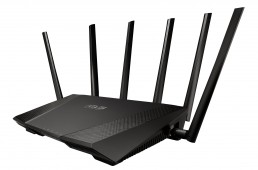802.11
Why Current Routers Are Substandard
Right now, there’s no perfect choice for consumers who are looking for a new router. Either the router won’t provide enough coverage, will have some issues maintaining a connection, or will have poor QoS (Quality of Service). Despite the fact that the majority of routers ship with most of their features intact, firmware updates are released so infrequently that any small bug can take months to resolve. This is a huge concern because within the next few years, the router may become the single most important component of the home computing experience.
Virtually all home networking routers are currently manufactured by a relatively small group of companies, all of whom purchase their chipsets from companies like Broadcom, Qualcomm Atheros, Quantenna, Celeno, and a few others. The most notable manufacturers in the consumer space are Netgear, ASUS, Linksys (now part of Belkin), Belkin, D-Link, Apple, TRENDnet, and Amped Wireless.
These companies’ latest products include ‘triple band’ AC routers that deliver 802.11ac in two 5 GHz bands and 802.11n in the 2.4 GHz band, usually with six antennas, such as the Netgear Nighthawk X6 and ASUS RT-AC3200. The routers also supposedly have bandwidth capabilities of up to 3.2 Gbps, despite the fact that the Ethernet port connecting the modem to the router is only capable of 1 Gbps.
Companies within the router industry label routers with terms such as AC1300, AC1900, AC2350 and AC3200, each of which indicate how many Mbps of bandwidth these routers are theoretically capable of providing. This means an AC3200 router would be 600 Mbps for the 2.4 GHz band, combined with two 5 GHz bands, each with 1300 Mbps of theoretical bandwidth. Together, those numbers combine to be 3.2 Gbps, even though realistically users can never see numbers like that, since no device can connect to all three bands simultaneously. Plus, when talking about connecting to the internet, the limitation will be based on the speed a person’s ISP provides, rather than the router’s bandwidth capabilities.
The need to have some level of overkill in terms of wireless performance makes sense when considering that signals weaken as devices are placed further away from the router, ensuring reasonable speeds even as some percentage of bandwidth is lost. However, many people buy these routers under the impression that they will be receiving a full 3.2 Gbps, and not something more like 300 Mbps or 181 Mbps.
Consumer routers have improved over time in terms of speed capabilities, number of ports, additional connectivity, and settings customizability. Despite all of these improvements, device support has taken a turn for the worse.
Although most routers ship with a basic 1 year warranty, it has become standard practice to only provide direct technical support for the first 90 days of a router’s use. This may be due to the fact that many consumers call their router manufacturer for assistance when their ISP is having a problem because they don’t know actually know what the difference is.
Even so, when a manufacturer provides a warranty on a product, they need to provide support up until that warranty period is over, for free. Apple is the exception in this case, as they have fantastic support for all of their consumer products, including routers. Also, Apple’s quality assurance seems to have much stricter standards than other consumer networking manufacturers, which means that frequent firmware updates are not as necessary for their routers.
Many router manufacturers won’t release firmware updates for their routers for months at a time, even when there are known firmware issues. Others will release firmware updates without thoroughly testing them, which causes them to put features into their routers that make them fundamentally insecure; ASUS’s countless security vulnerabilities being an obvious example here.
ASUS is no stranger to controversy, as they were accused of submitting fraudulent certification tests to the FCC in order for their routers to pass FCC certification. More importantly, their routers delivered higher signal output levels than the FCC allows (for safety concerns), and as a result, they seemed to perform better than their competitors in many reviews.
Eventually, the FCC found ASUS guilty of providing them with fraudulent certifications, and as a result, ASUS had to pay a $240,000 fine in order to ‘resolve equipment marketing investigations.’
The consumer wireless networking industry is fairly small, and most players simply do the same thing across the board, with just some minor differences in features. What these companies really need to start focusing on is improving customer service, as well as future technologies like MU-MIMO, which Linksys has already brought to market. Improved customer service also means squashing bugs through reliable and timely firmware updates and taking consumers’ concerns seriously. As more and more everyday devices and appliances start to utilize the internet for the first time, these companies will have to improve upon their routers that are quickly becoming an even more important component in the household.

